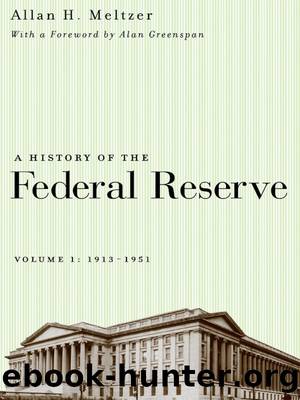A History of the Federal Reserve, Volume 1: 1913-1951 by Allan H. Meltzer

Author:Allan H. Meltzer [Meltzer, Allan H.]
Language: eng
Format: epub
Tags: Business & Economics, General, Government & Business, Economic History, Banks & Banking
ISBN: 9780226519982
Google: 190xVQDRtHAC
Publisher: University of Chicago Press
Published: 2010-02-15T20:39:27+00:00
SIX
In the Backseat, 1933 to 1941
The Federal Reserve took few policy actions from 1933 to 1941. The open market portfolio and the discount rate rarely changed. Changes in the monetary base during these years reflect principally changes in the gold stock and the devaluation of the dollar against gold; after the gold standard broke down the United States more closely followed gold standard rules for the money stock.
Congress and the Treasury made the important decisions about gold, silver, and banking legislation. Early in the administration, President Roosevelt took an active part in setting gold policy and making decisions about gold and silver purchases and exchange rates. The Federal Reserve had a subsidiary roleâthe backseat. New York transacted for the Treasury, as fiscal agent, but the Board had little influence on the decisions and was often uninformed about Treasury actions and plans.
The Banking Act of 1935 permanently changed the Federal Reserveâs structure and laid the foundation for the postwar Federal Reserve System. Out went the legal basis for semiautonomous, regional banks, each controlling its own portfolio. Reorganization shifted power and authority over the reserve banks to the Federal Reserve Board in Washington, where it remained. Although the Treasury controlled most decisions until after World War II, the 1935 act made possible the centralized system that developed once the Federal Reserve became free to pursue an independent policy.
Reorganization was mainly the work of Marriner S. Eccles, a Utah banker, aided by Lauchlin Currie, a young economist at the Treasury and later at the Board and in the White House as a presidential adviser. Eccles became governor of the Federal Reserve Board in November 1934 and, after reorganization, the first chairman of the Board of Governors in 1936. He was a strong proponent of government investment spending as a countercyclical policy and believed that the Federal Reserve should keep market rates low to facilitate private spending and government finance during a depression. He called his program âcontrolled inflation.â
Despite these strongly held views, Eccles and the Board became convinced after 1935 that the growing volume of reserves at member banks posed the threat of future inflation. The Boardâs principal policy action in these years increased reserve requirement ratios as a preemptive act against inflation. Between August 1936 and May 1937, the Board doubled these ratios, thereby contributing to a steep recession in 1937â38.
Until 1937, recovery from the depression proceeded rapidly. In the four years following the trough in March 1933, using Balke and Gordonâs (1986) data, real GNP rose at a compound annual rate of almost 12 percent. After a sharp decline in the 1937â38 recession, growth resumed in mid-1938. Real GDP did not reach its 1929 value until 1941, however, and per capita consumption did not regain its 1929 peak until 1942.1
Prices rose during the recovery, in part a result of deliberate policy to devalue the dollar so as to raise agricultural and commodity prices. The GNP deflator and the consumer price index remained below their 1929 levels, however, when the United States entered World War II.
Download
This site does not store any files on its server. We only index and link to content provided by other sites. Please contact the content providers to delete copyright contents if any and email us, we'll remove relevant links or contents immediately.
Bad Blood by John Carreyrou(6581)
Rich Dad Poor Dad by Robert T. Kiyosaki(6506)
Principles: Life and Work by Ray Dalio(6296)
Playing to Win_ How Strategy Really Works by A.G. Lafley & Roger L. Martin(6075)
Management Strategies for the Cloud Revolution: How Cloud Computing Is Transforming Business and Why You Can't Afford to Be Left Behind by Charles Babcock(4546)
The Confidence Code by Katty Kay(4217)
Thinking in Bets by Annie Duke(4182)
American Kingpin by Nick Bilton(3812)
Delivering Happiness by Tony Hsieh(3394)
Project Animal Farm: An Accidental Journey into the Secret World of Farming and the Truth About Our Food by Sonia Faruqi(3189)
The Power of Habit by Charles Duhigg(3092)
The Tyranny of Metrics by Jerry Z. Muller(3025)
Brotopia by Emily Chang(3024)
The Marketing Plan Handbook: Develop Big-Picture Marketing Plans for Pennies on the Dollar by Robert W. Bly(3005)
Mastering Bitcoin: Programming the Open Blockchain by Andreas M. Antonopoulos(3005)
I Live in the Future & Here's How It Works by Nick Bilton(2958)
The Content Trap by Bharat Anand(2885)
Applied Empathy by Michael Ventura(2864)
Building a StoryBrand by Donald Miller(2862)
